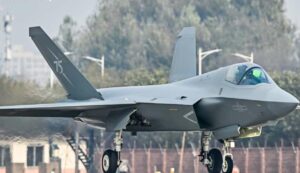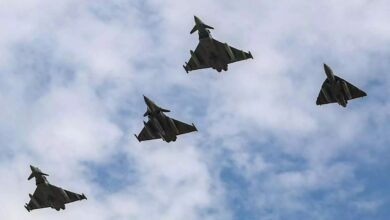China surprises everyone with its first presentation of fifth-generation J-35A fighter jets
Hong Kong: Immediately after the Zhuhai premiere of the fifth-generation J-35A fighter. During the November 12–17, 2024, airshow, China unveiled three new aircraft models on Boxing Day. Remarkably, two of them seem to be sixth-generation fighters, which would make China the first nation in history to successfully fly such sophisticated aircraft.

The spectacular and stunning arrival of two different sixth-generation fighters should not lessen the significance of China’s accomplishments.
Such fighters are being planned in the West, such as the Next Generation Air Dominance (NGAD) project in the USA, which the authorities are mulling over, although they are still in the planning stages. However, China has previously constructed and successfully flown prototypes.
On December 26, a mysterious fighter from Chengdu Aircraft Industry Group (CAC) became the first aircraft to be made public. Shenyang Aircraft Corporation (SAC) then released a different design. Later that day, pictures of a brand-new airborne early warning (AEW) aircraft based on the Xian Aircraft Corporation (XAC) Y-20 transport surfaced on the Chinese internet. Consequently, three of the biggest aircraft manufacturers in China relished their time in the spotlight.
Since it is improbable that any of the three clandestine aircraft made their first flights on that day, the Chinese government’s deliberate strategy of distributing films and still photos on Boxing Day is noteworthy. ANI recently met with a Chinese aviation enthusiast who was imprisoned for six months for taking and sharing pictures of planes. Netizens who share photographs of top-secret military equipment suffer harsh punishments.
Notably, Mao Zedong was born on December 26. Additionally, the Pentagon’s yearly assessment of China’s military condition was published on December 18th, just after the aircraft trio’s disclosure.
Beijing was furious that the paper “misinterpreted China’s defense policies, speculated about China’s military capacity development, flagrantly interfered in China’s domestic affairs, desperately slandered the Chinese military and exaggerated the so-called military threat posed by China.”
It seems that China wanted to render some of the study outdated in less than a week! While future-generation aircraft and an AEW platform based on the Y-20 were not included in that US study, the J-35 was. That being said, the US military establishment was not caught off guard. No, it wasn’t.
General Mark D. Kelly, who was in charge of the US Air Force’s Air Combat Command at the time, said in September 2022 that China was working on unmanned aircraft systems and sixth-generation fighters. China, according to Kelly, saw these aircraft “quite the same way we do: an exponential decrease in signature, an exponential increase in processing power and sensing.” Additionally, Kelly cautioned that the Chinese “are not dummies.” They are skilled at what they do.
We may take turns looking at the three planes. As a chase aircraft, a twin-seat J-20S flew alongside Chengdu’s manned fighter. Some are referring to this as the J-36 in relation to its serial number ‘36011’, as China has not made any public comments about its new platforms. Its stealth shape is similar to that of the J-20, and its wing angle indicates a top speed of Mach 1.8.
The aircraft’s absence of a vertical tail is one unique feature. The blended double-delta design uses five trailing-edge control surfaces per wing to help with agility in the absence of a vertical stabilizer. Because the tail is a significant reflector, eliminating it has the benefit of lowering the radar signature. Additionally, it provides aerodynamic efficiency, especially while cruising and at high speeds. Several years ago, satellite photography showed signs of a revolutionary tailless design from Chengdu.
Its three jet engines are another noteworthy feature. Why is this the case, even though the third inlet design is entirely different? The most apparent explanation is that no engine now made in China generates enough power to accomplish supercruise (sustained supersonic speeds) or to support a twin-engine configuration. It is speculative to assume that the two additional engines generate differential thrust and vectoring, while the central engine is used for takeoff, ascent, and supercruise. Two jets have standard caret inlets under the wings, while the third intake is a dorsal one on top of the fuselage.
Although the new aircraft’s engines are unknown, it would be logistically disastrous if the center engine differed from the others. In order to minimize the fighter’s heat signature, the exhaust nozzles for each of the three jets are placed side by side in the back.
The J-36’s enormous size is also noteworthy; it dwarfed the J-20, which was a big fighter in its own right. This implies that it is built to carry heavy quantities of fuel and weapons and to have lengthy endurance and range. Whether it has a single-seat or twin-seat arrangement is likewise unknown at this time.
Whether this is a sixth-generation fighter prototype or a demonstration serving as a testbed for next technology is still up in the air.
For a while now, China has been testing several fighter types, including subscale demonstrators.
How would it be utilized if it revealed the design of China’s next-generation fighter? China wants to dominate the area, take over Taiwan, and keep the United States at bay. A massive airframe like that can hold a lot of armaments and fuel. Two tandem-wheel landing gear units imply its weight, which is maybe approximately 120,000 pounds.
Its primary duty seems to be fighting opposing aircraft while flying long distances at high heights. Nonetheless, its huge weapons bay may hold missiles that could strike targets like air bases and aircraft ships or even unleash swarms of loitering bombs. Such aircraft can function more autonomously and undoubtedly serve as a control node for unmanned aircraft, which is something the People’s Liberation Army Air Force (PLAAF) is working to solve with the continued manufacture of the YY-20 tanker. These features would allow China to increase the operating envelope of its fighter force, requiring American and ally assets like AEW planes and air-to-air refuellers to fly at a greater distance.
The PLA specialist Rick Joe has previously called this aircraft the J-XD. “As with all contemporary tactical aircraft, a certain amount of multirole capability is expected, but this CAC aircraft is primarily air-to-air oriented,” he said. I see that a lot of people have suggested that this may be an outright bomber or a fighter bomber/striker. The J-36’s size is a reasonable justification. Without any obvious control surfaces showing through, it’s a Dorito flying wing.
He acknowledged that it did not seem to be a conventional air superiority aircraft. But all this relies on how you look at the ‘air superiority’ mission of the future,” Joe went on. Unmanned combat aerial vehicles (UCAV), collaborative combat aircraft (CCA), and other platforms are becoming more competent and deployed as part of a system-of-systems strategy that is widely adopted, notably by the US Air Force. The PLA is as well. As future aircraft concentrate on signature reduction, sensing, networking, controlling CCAs, weaponry, power generation, computing, and range/endurance, such advancements may reduce the relative usefulness of conventional maneuverability.
According to Joe, the J-36 is now estimated to be 21–23 meters longer than the J-20, with a wingspan of around 20 meters. That’s a huge aircraft for a blended delta flying wing with a rather thick fuselage. There is plenty of interior room and bulk, even with three engines.
It could carry more conventionally sized missiles or PL-17 extremely long-range air-to-air missiles for the air-to-air mission. It may carry a rotary launcher or perhaps stand-off weaponry inside for the striking role.
Joe wondered whether there were really that many distinctions between contemporary theater attack aircraft and long-range air superiority fighters. Larger, less visible combat aircraft are the current global trend, he added.
Joe said, “I suggest that in the near future, air superiority manned combat aircraft will be big, covert platforms that can command and process information to guide friendly unmanned aerial vehicles (UCAVs) and other manned fighters. They will also have their own weapons and sensors to engage, as well as enough kinematics to engage on their own terms.” Human attention in the cockpit will be the rate-limiting element, but the advantages of a manned air superiority combat aircraft are expected to increase as UCAVs/CCAs become more autonomous and onboard computing improves.
He also hinted that the name “fighter aircraft” would eventually become obsolete. Rather, “combat aircraft” might serve as the backbone of an aerial warfare system-of-systems, controlling unmanned aircraft in a persistent and covert manner while maintaining their own inherent lethality.
In conclusion, it is unclear whether this J-36 prototype foreshadows the PLAAF’s next sixth-generation fighter or only serves as a technical demonstration. Any analysis is made more difficult by the fact that China is reportedly creating a new fighter-bomber for the area. The JH-XX is the name of this project, and some believe the J-36 may be the direct result of it.
Its enigmatic features and look do, however, point to the path China is taking with regard to future combat aircraft. In fact, based on the J-20’s development history, a pre-production J-36 aircraft may be ready as early as 2029, with full production following a few years later.
Similar to CAC, the aerospace business located in Shenyang is working on a fighter with improvements in payload, range, sustained cruising speed, and low observability. This aircraft was smaller than Chengdu’s, and pictures of it were making the rounds on social media a few hours after the J-36’s spectacular appearance.
Since the cockpit compartment is not yet clearly seen in photographs, it may possibly be an unmanned design. Compared to the J-36, there are fewer images and films of the SAC aircraft, making evaluations of this design more challenging. However, it has no vertical tail and is obviously a twin-engine design. Shenyang is also not vying with Chengdu for a potential manufacturing deal. It would be a waste of limited resources to have two parallel designs compete with one another. The PLAAF may eventually have a medium-heavy fighter combo if it is not an unmanned aircraft, since it may be a lighter fighter than CAC’s concept.
Similar to how SAC released the FC-31 fighter initially before it changed into the very different J-35/J-35A, this full-size prototype may not be a pre-production aircraft just yet.
Although it is legitimate to compare the American NGAD with the CAC and SAC fighters as sixth-generation designs, Joe said that “the true measure of this comparison, in my opinion, depends on how representative the NGAD demonstrator(s) are of the final NGAD article procured by the USAF.” Naturally, this also holds true for the PLA aircraft, which may differ significantly from the two previously unveiled new designs.
Although its first flight may have taken place in November, the KJ-3000 is the provisional name of the third aircraft to share the limelight on December 26. This early warning aircraft was constructed by XAC and is based on the Y-20B transporter, which has four WS20 engines.
With its enormous radome and active electronically scanned array radars positioned atop the fuselage, this AEW version of the Y-20 was always anticipated. Whether the radome rotates is unknown. In addition to providing situational awareness and detecting hostile aircraft, an AEW aircraft’s long-range radar is likely equipped with electronic warfare and intelligence capabilities. A sizable bulge on the underside of the tail indicates this, although it is unclear from the picture quality if there are further fairings on the sides of the fuselage.
These aircraft will be more capable than the turboprop KJ-200 and KJ-500 systems based on smaller airframes, and they are required to replace earlier systems like the KJ-2000. The PLAAF currently has a fleet of around 60 AEW aircraft, and the KJ-3000 might easily become the most common.
China “unveiling” these three new planes in one day was a deliberate message. There are several concerns about the fighter classes in particular over their future development status and function within the PLA hierarchy. However, China has made it clear that the rest of the world has to pay attention to its military might.





